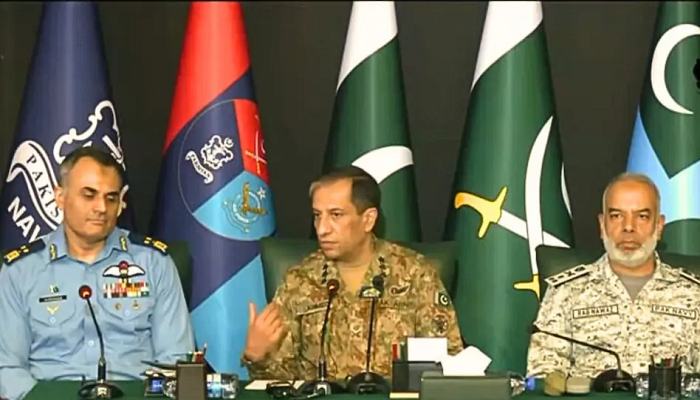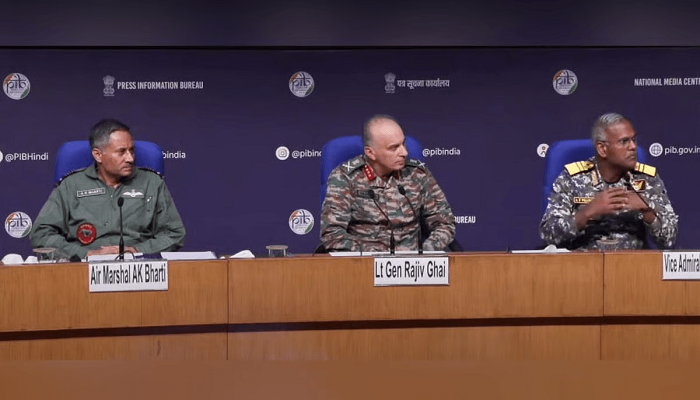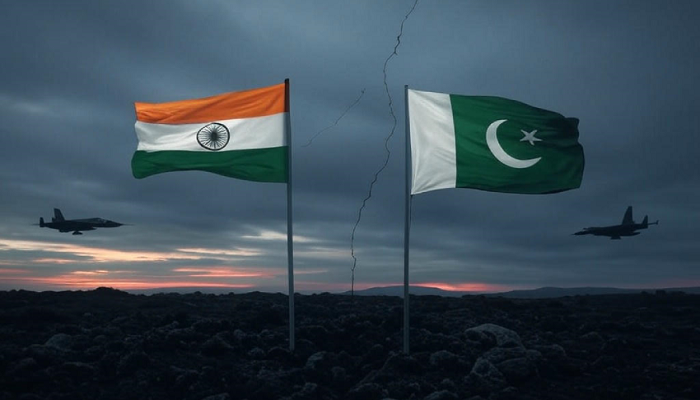Following a deadly attack in Jammu and Kashmir’s Pahalgam on April 22, India and Pakistan engaged in days of intense military confrontation across air, land, and sea.
Pakistan’s Operation Bunyan-un-Marsoos and India’s Operation Sindoor involved precision strikes, drone warfare, and cyber operations before a ceasefire was brokered. Both sides claim operational success and emphasize measured restraint.
A fragile calm has settled over the subcontinent after a week of intense military exchanges between India and Pakistan. Following international diplomatic efforts, both nations agreed to a ceasefire on May 11, halting escalating hostilities triggered by the April 22 Pahalgam attack in Jammu and Kashmir that left 26 people dead.
At a detailed press briefing in Islamabad, Director General of Inter-Services Public Relations (ISPR) Lt Gen Ahmed Sharif Chaudhry outlined Pakistan’s military strategy, denying that Islamabad had requested the ceasefire. “Let me put it on record: Pakistan never requested a ceasefire,” he stated, adding that it was India that approached first, and Pakistan only responded after executing its retaliation.
India and Pakistan Agree to Ceasefire Amid Kashmir Tensions, Violations Reported
Pakistan launched Operation Bunyan-un-Marsoos in response to what it described as unprovoked Indian aggression, claiming Indian strikes targeted civilian areas, including mosques and homes. Pakistan’s retaliatory operation involved precision strikes on 26 Indian military installations — including bases at Suratgarh, Sirsa, Adampur, Bhuj, Bathinda, Avantipur, and Udhampur — which Lt Gen Chaudhry said “sustained significant damage.”
The operation showcased Pakistan’s integration of air, land, naval, cyber, and drone warfare capabilities. Air Vice Marshal Aurangzeb Ahmed claimed that the Pakistan Air Force (PAF) downed several Indian aircraft and successfully neutralized India’s S-400 missile system in Adampur using hypersonic missiles fired by JF-17 Thunder jets. “We achieved a six-nil success ratio,” he said.
Pakistan also launched a cyber offensive that temporarily disrupted Indian communications and military networks. Simultaneously, armed drones conducted flyovers of major Indian cities, including New Delhi, as a show of strength and surveillance superiority.

Lt Gen Chaudhry emphasized that Pakistan’s actions were focused solely on military targets, in contrast to Indian operations. “Even from Indian statements, you won’t find any evidence of Pakistan targeting civilians,” he said, calling any escalation between two nuclear powers “sheer stupidity” and “an absurdity.”
The Pakistan Navy, under Vice Admiral Rab Nawaz, reported complete operational deployment within hours of the Indian airstrikes, maintaining constant maritime surveillance and readiness. “INS Vikrant was hyped as nearing Karachi, but we monitored it closely — it stayed 400 nautical miles away and eventually turned back,” he added.
Lt Gen Chaudhry praised the Pakistani people, youth, media, and political leadership for their unity during the crisis, calling the national response “measured, proportionate, and restrained” despite provocations.
South Asia on Edge as India and Pakistan Trade Fire, Drones, and Accusations
India, on the other hand, described its response to the Pahalgam attack as swift and forceful. On May 7, the Indian Armed Forces launched Operation Sindoor, a coordinated multi-branch offensive targeting terrorist infrastructure in Pakistan-administered Kashmir and mainland Pakistan.
Indian DGMO Lt. Gen. Rajiv Ghai, Air Marshal AK Bharti, and Vice Admiral AN Pramod held a joint press briefing to disclose the operation’s execution.
Air strikes were conducted on Pasrur, Chunian, Arifwala, and multiple Pakistani airfields — including Sargodha, Chaklala (Nur Khan), Rahim Yar Khan, Bholari, Sukkur, and Jacobabad. Air Marshal Bharti confirmed the destruction of multiple terrorist camps and air defence sites, stating, “We achieved our objectives, and all our pilots are back home safely.”
India confirmed that its air defence systems repelled a large-scale drone and missile attack launched by Pakistan from the night of May 8 to the morning of May 10, targeting Indian cities and logistics hubs. DGMO Ghai reported that integrated Indian Air Force and Army units “denied all attempted intrusions gallantly and efficiently.”

India also reported Pakistani casualties along the Line of Control. “Pakistan Army lost approximately 35–40 personnel in artillery and small arms firing from May 7 to May 10,” said Lt Gen Ghai.
The Indian Navy mobilized its carrier battle group and strike submarines within 96 hours of the Pahalgam attack. “We deployed in a forward, deterrent posture with readiness to strike key targets, including Karachi,” said Vice Admiral Pramod. He emphasized that the Indian Navy forced Pakistani naval units into a defensive stance.
US Urges India-Pakistan Dialogue Amid Rising Tensions Following Pahalgam Terror Attack
Lt Gen Ghai paid homage to five Indian soldiers lost in action during Operation Sindoor and reiterated that India’s response had been “focused, measured, and non-escalatory.”
After days of mutual strikes and high alert, both nations agreed to a ceasefire on May 11. Foreign Secretary Vikram Misri confirmed that military leaders from both sides established direct communication, facilitated by international mediators including U.S. President Donald Trump.
Pakistan’s DG ISPR stressed that the ceasefire came only after Islamabad delivered a proportionate response and underlined Pakistan’s commitment to avoiding civilian harm. India, on the other hand, framed its actions as a necessary counterterrorism measure to protect its sovereignty and civilian population.
While the ceasefire has halted active hostilities, both sides continue to issue strong statements asserting military superiority and defensive legitimacy. The scale and sophistication of the operations — from hypersonic weapons and drone swarms to cyber offensives — reflect the increasing complexity of modern conflict between the nuclear-armed neighbours.
Observers warn that although a full-scale war was narrowly avoided, the underlying tensions remain unresolved. Diplomatic channels remain open, but the events of early May 2025 have once again underscored the volatility of the India–Pakistan relationship — and the catastrophic risks of escalation in South Asia.



